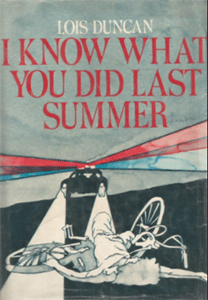“I Know What You Did Last Summer” was a hit horror movie in 1997, and it’s still a viable franchise today, with a TV series re-imagining having come out in 2021. So why did the author of the 1973 young-adult novel, Lois Duncan (1934-2016), loathe the film? Because it changed its genre! The novel is not a slasher, and arguably not even horror.
But on the plus side, the book did get a second life in 1997 thanks to the movie tie-in edition that features the poster art of the four hot-list stars (Jennifer Love Hewitt, Sarah Michelle Gellar, Freddie Prinze Jr. and Ryan Phillippe).
Mystery, not slasher
I was intrigued to learn on my recent read that Duncan’s book is a mystery. (SPOILERS FOLLOW.) Only one person is killed: a 10-year-old boy on a bicycle. Barry, Helen, Julie and Ray hit the kid on a winding mountain road, then continue to the nearest pay phone (remember, it’s 1973) to anonymously call an ambulance.

“I Know What You Did Last Summer” (1973)
Author: Lois Duncan
Genre: Young adult, mystery
Setting: Unnamed western American town, 1973
Duncan maximizes mystery and suspense. She starts with Julie (red-haired, unlike Hewitt) getting the classic hand-printed note that the anonymous sender knows what she did last summer. The other three get similar messages.
It’s a while till we learn they ran over a kid. “IKWYDLS” explores guilt and responsibility in a way young readers will find striking, even today. The quartet regularly weighs what happened and what they could’ve done.
They could’ve reacted to the accident better; they could’ve handled it worse – at least they called for help. At any rate, they decided to stay anonymous. It would be too risky for the future of Barry – the driver, and the only one who is legally an adult. All four were lightly smoking pot in this early time of the Drug War.
In the film – infamously – the killer is the Fisherman whom the kids ran over. He inexplicably survives, and then functions as a Guilt Monster. This is made explicit in the weak third film, and the TV series continues the supernatural aspect in more intriguing fashion.
Honest exploration of guilt
Duncan’s novel – written in crisp, clear style for YA readers — is down-to-earth and emotionally real. Oddly, the movie’s wake-of-“Scream” slasher kills are escapism for the viewer. We don’t have to dwell on the guilt when the hit-and-run perps (who we like but aren’t super attached to) become the victims.
The book’s characters are more thoroughly developed, but recognizable. Julie (Hewitt in the film) has a different hair color but remains the Everyteen. Helen (Gellar) is so gorgeous that she’s able to skip her last year of high school to become the weather and PR girl for the local TV news station.

Barry (Phillippe) goes to the local university on a football scholarship, and Ray (Prinze Jr.) takes California dock jobs for several months before returning and looking up his ex, Julie. The film is set on the East Coast; the book is perhaps in Colorado.
As the author herself contended, a mystery is a less crass genre for exploring the aftermath of the accident. Clues come from behaviors and motivations. We eye with suspicion Helen’s frumpy, jealous older sister, Elsa (turned hot in the film, natch, where she’s played by Bridgette Wilson). There’s also Julie’s time-killing regular date Bud, and Helen’s apartment neighbor friend Collie – who don’t have film equivalents.
Plus, a park ranger saw the teens from a distance on the fateful night. Also, are the relatives of the 10-year-old boy somehow in the know?
Tough to adapt
I figured out the note-sender’s ID quite a while before the reveal. Then I figured out the wrinkle of the perpetrator slightly before the reveal. But I felt smart for doing so; I usually don’t figure out Agatha Christie whodunits.
Readers will understand what I mean when I say Duncan’s narrative would be hard to faithfully adapt to screen. It requires that a piece of knowledge be hidden, something that can be easily done in book form but not as easily in screen form.
It’s understandable that screenwriter Kevin Williamson changed some things, but in changing the genre (as he was instructed to do), we have a situation where Duncan’s book has never truly been adapted. It was mined for its premise and characters. Effectively, sure — I admit I’m a fan of the film, plus the first sequel and the underrated TV series.
The book deserves some love, too, for its 50th anniversary year. Fans of the film might enjoy picturing the quartet of teens in their head as they go through detailed inner thoughts and a different batch of thrilling experiences. They may all survive in the source material, but the original “I Know What You Did Last Summer’s” guilt and trauma aren’t lessened by that fact.

